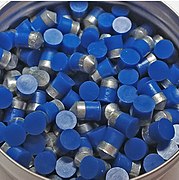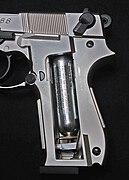
A muzzle brake or recoil compensator is a device connected to, or a feature integral to the construction of, the muzzle or barrel of a firearm or cannon that is intended to redirect a portion of propellant gases to counter recoil and unwanted muzzle rise. Barrels with an integral muzzle brake are often said to be ported.

An air gun or airgun is a gun that uses energy from compressed air or other gases that are mechanically pressurized and then released to propel and accelerate projectiles, similar to the principle of the primitive blowgun. This is in contrast to a firearm, which shoots projectiles using energy generated via exothermic combustion (detonation) of chemical propellants, most often black powder or smokeless powder.

A BB gun is a type of air gun designed to shoot metallic spherical projectiles called BBs, which are approximately the same size as BB-size lead birdshot used in shotguns. Modern BB guns usually have a smoothbore barrel with a 4.5 mm (0.177 in) caliber, and use steel balls that measure 4.3–4.4 mm (0.171–0.173 in) in diameter and 0.33–0.35 g (5.1–5.4 gr) in weight, usually zinc- or copper-plated for corrosion resistance. Some manufacturers still make the slightly larger traditional lead balls that weigh around 0.48–0.50 g (7.4–7.7 gr), which are generally intended for use in rifled barrels.

A semi-automatic pistol is a repeating handgun that automatically ejects and loads cartridges in its chamber after every shot fired, but only one round of ammunition is fired each time the trigger is pulled. The pistol's fire control group disconnects the trigger mechanism from the firing pin/striker until the trigger has been released and reset manually, unlike the self-cycled firing mechanism in fully automatic pistols.

A gun barrel is a crucial part of gun-type weapons such as small firearms, artillery pieces, and air guns. It is the straight shooting tube, usually made of rigid high-strength metal, through which a contained rapid expansion of high-pressure gas(es) is used to propel a projectile out of the front end (muzzle) at a high velocity. The hollow interior of the barrel is called the bore, and the diameter of the bore is called its caliber, usually measured in inches or millimetres.

The Welrod is a British bolt-action, magazine-fed pistol with an integrated silencer which was devised for covert operations during the Second World War by Major Hugh Reeves at the Inter-Services Research Bureau.
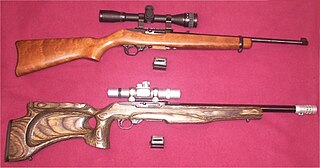
Accurizing is the process of improving the accuracy and precision of a gun.

A riot shotgun is a shotgun designed or modified for use as a primarily defensive weapon, by the use of a short barrel and sometimes a larger magazine capacity than shotguns marketed for hunting. The riot shotgun is used by military personnel for guard duty and was at one time used for riot control, and is commonly used as a door breaching and patrol weapon by law enforcement personnel, as well as a home defense weapon by civilians. Guns of this type are often labeled as breaching shotguns, tactical shotguns or special-purpose shotguns to denote the larger scope of their use; however, these are largely marketing terms.

The Heckler & KochP7 is a German 9×19mm semi-automatic pistol designed by Helmut Weldle and produced from 1979 to 2008 by Heckler & Koch GmbH (H&K). The P7M13, a variant of the P7 with a double-stack magazine, was produced until 2000.
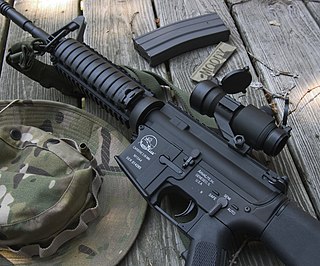
Airsoft guns are replica guns used in airsoft sports. They are a special type of low-power smoothbore air guns designed to shoot non-metallic spherical projectiles (bb) often colloquially referred to as "BBs", which are typically made of plastic or biodegradable resin materials. Airsoft gun powerplants are designed to have low muzzle energy ratings and the pellets have significantly less penetrative and stopping power than conventional airguns, and are generally safe for competitive sporting and recreational purposes if proper protective gear is worn.

Crosman Corporation is an American designer, manufacturer and supplier of shooting sport products, with a long-standing presence in airgun design and a tradition of producing pellet and BB guns. Crosman is also a producer of many varieties of airgun and airsoft ammunition and CO2 Powerlet cartridges. In addition, Crosman sells branded, licensed products as well as a variety of airsoft guns.
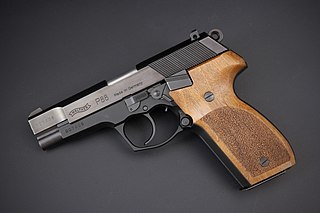
The Walther P88 is a semiautomatic pistol developed by German company Walther. Its main feature is a double-stacked magazine designed for military and law enforcement use. The P88 was succeeded by the Walther P99 in 1997.
Umarex air pistols are air gun replicas of handguns manufactured by Umarex Sportwaffen of Germany under license from the manufacturers of the original firearms.

The Steyr LP 10 is a single shot 4.5 mm (0.177 in) calibre pre-charged pneumatic air pistol designed for the 10 metre air pistol ISSF shooting events. It is manufactured by Steyr Sportwaffen GmbH of Austria.
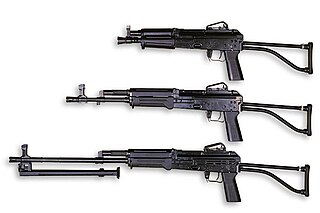
The ČZ 2000 is a prototype 5.56 mm caliber Czech weapon system, consisting of a standard rifle, carbine and light machine gun. The system was developed in 1991 after adapting the LADA firearm prototype J. Denel from the Brno-based Prototypa-ZM company is the chief designer for both systems. The ČZ 2000 was to be produced by Česká zbrojovka of Uherský Brod. It was planned to be the new service weapon of the Czech Army, replacing: the 7.62 mm vz. 58 assault rifle, 7.65 mm vz. 61 Škorpion submachine gun and 7.62 mm vz. 59 machine gun. As of 2007, the project has been discontinued.
The following are terms related to firearms and ammunition topics.

Title II weapons, or NFA firearms, are designations of certain weapons under the United States National Firearms Act (NFA).
The Manville gun was a stockless, semi-automatic, revolver type gun, introduced in 1935 by Charles J. Manville. The Manville Gun was a large weapon, with a heavy cylinder being rotated for each shot by a clockwork-type spring. The spring was wound manually during the reloading.

9mm P.A., 9×22mm or 9mm P.A.K. is a firearm cartridge for a non-lethal gas pistol noisemaking gun. Caliber 9mm P.A. includes various blank, gas or rubber ammunitions made for different use.

A repeating firearm or repeater is any firearm that is designed for multiple, repeated firings before the gun has to be reloaded with new ammunition.




